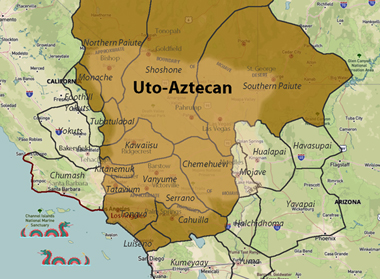Uto-Aztecan Tribes
Uto-Aztecan is younger than Hokan or Penutian. Research indicates that Uto-Azetcan began to
diversify in California after Hokan and Penutian were present, but before all of the Penutian
languages achieved their later prehistoric distribution. Uto-Azetecans first entered California
earlier than circa 2000 BC.
Cahuilla
Chemehuevi
-
Native Location: Southeastern California on the Arizona border and the
Colorado River,
from
Death Valley
to the Maria Mountains
Language: Paiute [Southern Numic]
Identified Shelters: Dome-shaped structures made of sapling poles joined at the center, and thatched with brush
Food: Corn, beans, pumpkin and melon; deer, rabbit, mountain sheep
Cultural Notes: They were once nomadic; they fought and intermarried with their nearest neighbors, the Mohave.
Gabrielino/Tongva
-
Native Location: Southern California, Los Angeles and Orange County areas
Language: Takic
Identified Shelters: Large, multi-family structures covered with tule
Food: Acorn, pine nuts, berries, deer, fish, small game
Kawaiisu
-
Language: [Southern Numic]
The Kawaiisu are unique amongst indigenous people because they have no migration story. From an anthropological standpoint, this means that they have always lived in the same place. Even some of the most studied of the ancient civilizations in the America’s, for example the Aztec, have a migration story that was passed down to each generation thru oral history. This lack of a migration story explains why the Kawaiisu territorial pictographs are often pre-dated by adjacent petroglyphs and geoglyphs. The combination of Kawaiisu pictographs and petroglyphs verify that they have lived in this region since time immemorial.
Serrano
-
Native Location: Mojave Desert and the San Bernardino Mountains in Southern California
Food: Acorn, Manzanita berries, pine nuts, yucca, deer, rabbit,
Language: Takic branch of Uto-Aztecan
Cultural Notes: They were once sedentary hunter-gatherers. Serrano is Spanish for "mountaineer", but they called themselves Yuharetum, which means "people of the pines."
Paiute
(Northern Paiute)(Mono Paiute/ Kutzadikaa) (Owens Paiute)-
Native Location: Northern and Owens Valley Paiute
lived along the eastern slope of the Sierra Nevada mountains from Oregon to Owens Valley;
Southern Paiutes lived along southeastern California
Language: Northern Paiutes spoke a Shoshonean dialect; Southern Paiutes spoke Numic
Identified Shelters: Small, circular structures covered with tule rushes
Food: Corn, squash, pumpkin, melon, beans, sunflowers, blueberries, elderberries, currants, wild strawberries, deer, mountain sheep, antelope, small game.
Cultural Notes: The origin of the word Mono (pronounced “mo-no,” unlike “ma-no,” the Greek word for one) is uncertain. Like so many Native American words in common use today its meaning is not well documented. The most accepted theory is that Mono is a Yokut word for “fly eater.” The Yokut people were native to the western Sierra Nevada slopes above present-day Fresno, some 200 miles from the Mono Basin. How did the word Mono travel to this region? Perhaps the word was first used to describe the Southern Paiute in the Owens Valley who also harvested alkali fly pupae. The Kutzadika’a people do not have Mono in their language and history does not offer a clear explanation of its origin.
Shoshone
-
Native Location:
Death Valley National Park
contains approximately 80 percent of the Shoshone's known traditional, cultural, and sacred sites
Language: Shoshone
Identified Shelter: Semi-subterranean, cone-shaped structures with a connecting pole framework, covered with pine needles
Food: Pine nuts, Mesquite beans, elk, buffalo, bighorn sheep
Cultural Notes: They were once hunter-gatherers.
Tataviam
-
Native Location: The Tataviam region stretches from the San Fernando Valley and Santa Clarita Valley to the
Antelope Valley
and can be traced as far back as 450 A.D. At that time the Tataviam people migrated from the north and
settled in villages throughout the area. The villages were constructed on the south-facing sides of hills
and mountains because they received the most sun light.
Cultural Notes: The word Tataviam means "people facing the sun" and decribes the Tataviam's villages.
Tongva
-
Cultural Notes: This tribe's lifestyles paralleled the Gabrielino/Tongva.
Western Mono/Monache
-
Native Location: South-central Sierra Nevada foothills
Language: Shoshone
Indentified Shelters: Semi-subterranean, cone-shaped structures with a connecting pole framework, covered with pine needles
Food: Acorn, pine nuts, deer, fish, manzanita berries, gooseberries, seeds, mushrooms
Other Uto-Aztecan Tribes
-
Kitanemuk
-
Koso
-
Tubatulabal
* Moratto, Michael, California Archaeology, Academic Press, Inc., 1984
Source - State of California
